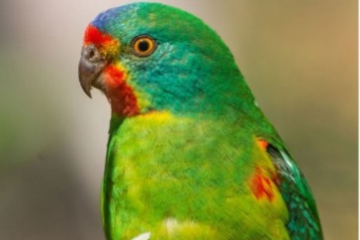Some strategies to help protect and restore habitat during bush regeneration and revegetation activities.
Guiding Principles
- Protect existing wildlife habitat and create new habitat for existing and restorable wildlife.
- Control problem weeds while allowing new habitat areas to mature.
- Restore existing degraded habitat once new habitat areas are providing shelter and food resources.
- Link areas of existing remnant vegetation and other habitat with revegetation to increase shelter and foraging sites and provide travel corridors for wildlife.
- Reduce disturbance or predation of native fauna by humans, feral and domestic animals (e.g. foxes, dogs, cats), predatory or territorial native animals (Pied Currawongs, Noisy Miners) by reducing easy access to important habitat.
General Strategies
- Locate important habitat areas. Potentially important habitat areas can be assessed by the existence of remnant vegetation, mature trees (particularly Angophoras and Eucalypts), dense understorey (particularly indigenous species), native fauna, exposed rock, logs and leaf litter and clean water. Look out for bird nests and Common Ringtail Possum dreys (nests) in dense understorey (including Lantana), listen for the calls and activity of nestling birds and feeding parent birds to indicate nest sites (follow cats with preoccupied looks on their faces, and then chase them away!).
- Identify potential wildlife sanctuary areas which are currently unused by humans and which could be restored to enhance the likelihood of them remaining undisturbed by humans and predatory animals in the future.
- Assess the habitat provided by weeds before attempting removal. For example, vines in trees provide shelter for roosting and nesting birds, and Common Ringtail Possum dreys.
- Avoid carrying out weed removal in areas providing important habitat for existing wildlife until nearby substitute habitat is provided.
- Try to plan weed removal so that it can be carried out in a mosaic pattern leaving patches of undisturbed vegetation (particularly important habitat areas) adjacent to worked areas to maintain shelter and food resources and to reduce predation and erosion.
- Try to carry out major weed removal outside the main local bird breeding seasons. If necessary, in shelter areas, carry out target weeding of problem species such as exotic vines in native trees and then leave the site undisturbed until adjacent sites are providing shelter and food resources.
- Try to link habitat areas with a vegetated corridor. Plant dense, spikey understorey to increase shelter and foraging sites particularly for the small, insectivorous birds.
- Try to repeat the density and species mix in revegetation sites that occur naturally in nearby remnants with similar conditions (such as soil and aspect).
- Where Pied Currawongs are a problem, restrict the number of indigenous fruit-bearing plant species in revegetation work. Although these plants may provide food for small birds and other animals such as butterflies and flying-foxes, they may help increase the Pied Currawong population, a major predator of eggs, nestlings and occasionally adult birds.
- Where Noisy Miners are a problem, use insect-pollinated, rather than bird-pollinated, plants to avoid attracting these large territorial honeyeaters. These insect-pollinated plants will include wattles, peas and tea-trees
- With Tawny Frogmouths, Common Ringtail Possums and other more obvious wildlife, try to only approach or work in areas if resident animals are away from the site. If you need to approach the site be very quiet, talk in low, calm voices and avoid making any sudden, loud noises or calling out (unless trying to scare an animal away from a potentially dangerous situation).
- When weeding around the base of large boulders, previously secure wildlife shelters may be exposed, leaving wildlife vulnerable to predation. Try to carry out the work over a number of weeks or, preferably, partially weed and revegetate and then allow the planting time to mature and provide cover. Then repeat the process.
- Plant around the base of large outcropping boulders in regeneration/ revegetation areas to improve shelter provided to lizards and other fauna. Take care to select plants appropriate to the soil moisture levels.
- Before weeding, bagging, burning or otherwise altering recently undisturbed habitat (including weed piles), disturb by noise, agitation with sticks, or shaking to give resident animals an opportunity to get away and find alternative habitat. Preferably do this 24 hours or at least some hours beforehand.
- Try to minimise the impact of stormwater drains and boggy areas on remnant dry heathland and woodland. Plant margins of drains and boggy areas with native sedges, grasses, ferns and shrubs which can tolerate wet feet and occasionally drying out.
- Try to create small wetland areas to provide clean, safe water sources for drinking, cooling, bathing, sloughing skin and habitat for local birds, lizards, frogs and insects such as dragonflies. Care is needed with possible sources of water pollution.
- Replace logs, rocks and leaf litter wherever possible to provide shelter, and foraging and breeding sites for lizards and invertebrates.
- Use smaller branches for stabilizing steep slopes or in pile burns to stimulate regeneration.
- Remove weed trees gradually to maintain the resources they are providing while allowing more sun to reach the ground and stimulate regeneration of understorey and native trees such as Angophoras and Eucalypts. Consider poisoning 1 or 2 weed trees every 5 years and informing local residents beforehand. Consider poisoning in autumn to mimic natural cycles of some exotic trees.
- Care is needed when using weed mats. They may create a barrier to wildlife and to rainwater. However, they can be useful on fill slopes when installed correctly and mulched.
© Danie Ondinea March 2000
Australian Association of Bush Regenerators (NSW) Inc. 2006
Adapted from Ondinea, D. (1997) Habitat Protection and Restoration Guidelines for Cremorne Reserve. Prepared for North Sydney Council and the Metropolitan Greenspace Program.


Leave A Comment